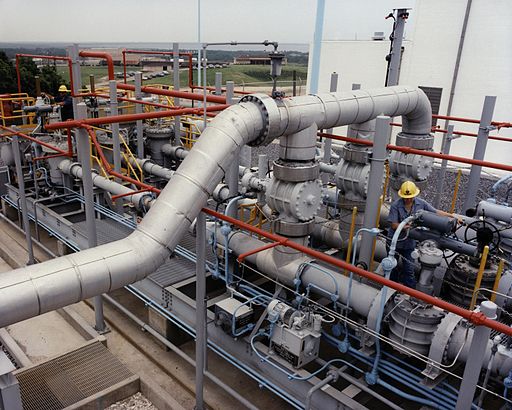Memorandum for President Trump
Subject: Your Energy Inbox in Year 1
As a candidate, you made a high priority of improving the supply of energy and promoting the energy business as an end in itself. Given the challenge of passing comprehensive energy legislation—even with a Republican-controlled Congress—the executive branch has inherited a number of administrative decisions from the Obama Administration. How you and your cabinet address these—in particular, your energy secretary and Environmental Protection Agency (EPA) administrator—will go a long way in determining how you balance the priorities of energy supply, energy transformation, and energy security.
Your inheritance: Gridlock, enhanced supply, regulatory choice

In 2008, Barack Obama campaigned on energy transformation but ultimately his administration presided over a different transformation than it had anticipated.
In 2008, then-Senator Barack Obama campaigned on energy transformation. At that point in history, a vision of distributed, renewable generation sources powering smart appliances in efficient buildings, with electric cars that received fuel from—and served load to—a smart grid, offered economic promise to price-shocked voters.
Ultimately, the Obama Administration presided over a different transformation than it had anticipated. Oil and gas companies unlocked new fossil energy wealth from shale and other “tight” formations, and the nation began reinterpreting four decades of scarcity-based policy for an age of adequacy.
Partly because of congressional gridlock, primary policy-setting responsibility fell to the executive branch, with federal courts frequently providing more of a counterweight to the administrative agenda than the Congress itself. As a result, you have inherited numerous legal challenges. States, industry, and, in some cases, environmental stakeholders have brought suits against an array of new rules and proposals governing the upstream, midstream, downstream, and end-use segments of the energy value chain. You are likely to have to resolve many of these issues, setting policy in the process.

The U.S. Strategic Petroleum Reserve consists of five underground crude oil storage facilities in Texas and Louisiana. Weeks Island, located in south central Louisiana, is the only site where crude oil is stored in an underground salt mine.
You will also oversee the recalibration of U.S. energy security. The 114th Congress mandated significant crude oil sales from the U.S. Strategic Petroleum Reserve (SPR) to pay for nonenergy priorities. This may have seemed like a nonissue during a time of low commodity prices and slow economic growth, but it should not be ignored. The tightly strung oil market can move quickly from surplus to deficit, and large inventories may be masking market perceptions of serious instabilities in producer nations. At any point over your term, the United States and other Organisation for Economic Co-operation and Development (OECD) nations that are net oil consumers could face another price spike with its attendant economic effects. If that occurs, you are likely to have to address rising prices. This could prove more challenging than it was in the past, when energy politics focused primarily on end-user costs, now that producers have become increasingly important contributors to U.S. economic growth.
An old law and a changing world
A number of items in your inbox—such as the Clean Power Plan (CPP), methane performance standards for oil and gas wells, and biofuels blending volumes under the Renewable Fuel Standard (RFS)—rely on portions of the Clean Air Act that may be ill-suited for controlling greenhouse gas (GHG) emissions, outmoded relative to current market conditions, or both. The implications for your administration extend beyond policy itself. The complex regulatory formulations needed to repurpose an old law to new ideological targets and unanticipated market dynamism can to lead to lengthy lawsuits, with the undesirable consequences of prolonging uncertainty and delaying investment.
The Clean Power Plan
As things currently stand, the regulatory architecture of President Obama’s Climate Action Plan was intended to eventually govern most industrial activities within the U.S. economy, and the Clean Power Plan served as its symbolic foundation. Deconstructing this regulatory architecture will not be easy. Your EPA administrator, Scott Pruitt, may win voluntary remand of the currently stayed Clean Power Plan from the D.C. Circuit, but that move represents the start—not the end—of a process. Neither environmental activists nor judicial precedent will make it easy, or even possible, to simply abandon GHG controls for power plants. A conservative- led Supreme Court already had ruled on behalf of states such as Massachusetts and California that the executive branch (and thus, the EPA) must regulate carbon under the Clean Air Act. In addition to environmentalists, many states are now likely to continue to sue the EPA to do just that.
Rewriting the Clean Power Plan could take two years or longer, and if Pruitt opts for a narrower interpretation of the “Best System of Emission Reduction” (BSER) by relying solely on coal plant efficiency upgrades and natural gas substitution, his legal staff might spend another two years defending that decision in court. This replacement plan has significant potential to affect other industrial sectors. For example, the same December 2010 consent decree that obligated the EPA to regulate power plant GHG emissions also required the EPA to regulate GHG emission from refineries. For this reason, the original Clean Power Plan served as a prototype that might have enabled the EPA to include upstream production and downstream blending components within its BSER for refineries—a de facto low-carbon fuel standard (LCFS) that would have regulated all transportation fuels. Successfully defending a narrower construction could similarly limit future requirements imposed on other sectors promulgated by a differently minded future White House to efficiency upgrades and fuel substitution for the rest of the industrial economy.

President Donald Trump appointed Scott Pruitt to head the Environmental Protection Agency (EPA).
Judicial outcomes won’t just affect the Clean Power Plan, but the power sector as a whole. Coal-fired plants upgraded to meet the Mercury and Air Toxics Standards have returned to service. In addition, long-term extensions of the investment tax credit for solar energy and the production tax credit for wind power remain in force through 2021, setting the stage for green power supply growth. Flat-to-down power demand and weak power prices are putting a growing number of projects, including nuclear power plants, in financial peril. The longer the EPA takes to provide regulatory clarity, the more oversupplied U.S. electric generation could become.
Methane from oil and gas wells
President Obama’s Climate Action Plan included a separate methane strategy aimed at reducing oil and gas sector methane emissions to between 40 percent and 45 percent below 2012 levels by 2025 through a combination of voluntary and regulatory measures. Environmental activists had been calling for years for an explicit rule that went beyond the EPA’s 2012 oil and gas sector performance standards for volatile organic compounds and hazardous airborne pollutants (also known as the “green completion” rule), which reduced methane emissions as a “co-benefit.” Industry countered that green completions and native economic incentives were sufficient to curtail methane.
In August 2015, the Obama Administration proposed methane standards for new wells and initiated EPA oversight of voluntary industry-led emissions reduction initiatives. In March 2016, however, President Obama and Canadian Prime Minister Justin Trudeau issued a Joint Statement on Climate, Energy, and Arctic Leadership pledging that both countries would “regulate existing sources of methane in the oil and gas sector” and that the EPA “will begin developing regulations for methane emissions from existing oil and gas sources immediately and will move as expeditiously as possible.” As a result, in May 2016 the EPA issued its final methane rule for new sources. In March 2017, Pruitt halted the Obama administration’s Information Collection Request (ICR) regarding existing sources, effectively suspending future methane regulations at existing oil and gas wells. The EPA could also rewrite the previously finalized new source rule.
As you and your team pursue this deregulatory agenda, you may encounter occasional and perhaps unexpected pushback from some industrial stakeholders. Some representatives of heavy industry are likely to ask for replacement and, in some case, additional regulations they can abide—including a methane rule for existing sources—in hopes of obviating strict future rules imposed by a future president who places environmental protection ahead of economic growth. Indeed, inasmuch as you recognize the role regulatory stability plays in investment success, you may find it wiser to establish realistic regulation aimed at making business easier for the long term rather than merely deregulating to make business cheaper for the short term.
The EPA’s methane rule isn’t the only one likely to be in court, either. Congress is working to repeal the venting and flaring rule from the Bureau of Land Management (BLM) for oil and gas production on federal lands using the Congressional Review Act, but a narrowly divided Senate could make ongoing legal challenges a more realistic rollback pathway. Another controversial BLM regulation, the agency’s May 2015 fracking rule for federal lands, which a Wyoming federal judge overturned in June 2016, is currently on appeal before the Tenth Circuit. These judicial outcomes, in conjunction with producer states continuing to seek regulatory primacy, could force you to revisit the balance between state and federal oversight of oil and gas production and the degree to which your administration relies on central policies versus decisions taken by field offices in producing states.
The Renewable Fuel Standard
The Obama Administration initiated the CPP and the methane strategy, but it inherited the vexing inconsistencies posed by the RFS. A scarcity of light, sweet oil and gasoline threatened U.S. economic welfare when Congress created the RFS in the 2005 Energy Policy Act. In the 2007 Energy Independence and Security Act (EISA), as the nation’s gasoline demand climbed toward what then appeared to be its all-time peak, Congress nearly quintupled the RFS target to its current 36 B gal/Y levels. The RFS’s volumetric targets continued to rise even as motor fuels demand decreased, forcing refiners and importers against a de facto 10 percent limit imposed by vehicle warranties and fueling equipment capabilities, the so-called “blend wall.”
In May 2015, the EPA proposed a consolidated RFS for 2014, 2015, and 2016. The volume requirements in the proposed and final rules were considerably higher than those implied by the agency’s original methodology—although still lower than EISA-mandated levels—and the 2016 target exceeded the “blend wall.” The EPA relied on a bank of “carryover” RINs (Renewable Identification Numbers, surplus credits retained from previous years). In addition, rising motor fuel demand created room in the gasoline pool for more ethanol blending. As the RIN pool draws down and gasoline consumption flattens with improved fuel economy, however, new price pressures are likely to await you. Litigation before the D.C. Circuit will be waiting, too. Challenges to the 2014–16 RFS are due for oral argument in the spring and the case may not be decided until the fall or winter. High RIN prices, pending litigation, and the requirement that EPA establish volumetric requirements each year ensure that you will have to address challenges posed by the RFS.
Energy security: The calm before the storm?

The Bureau of Labor Statistics reported in December 2016 that the oil and gas labor force had contracted by 32 percent from its October 2014 peak.
You will preside over the continuing rationalization of U.S. oil and gas production. As of December 2016, the Bureau of Labor Statistics reported that the oil and gas labor force—inclusive of services companies that support production—had contracted by 32 percent from its October 2014 peak, a loss of 209,000 jobs. As of December, U.S. production was down only 8.7 percent (about 844 kbbl/d) below its more recent (March 2015) peak, with tight oil accounting for about 69 percent of that decline. Jobs and production are starting to recover, but this is no time for complacency.
Price and production data from the U.S. Energy Information Administration and rig count data from Baker Hughes indicate that drilling responded to significantly lower prices much more promptly than production did. It seems reasonable that a shale oil supply expansion in response to significantly higher prices could demonstrate similar latency, especially after such stark job cuts. Even if U.S. producers could quickly add production, the International Energy Agency (IEA) estimates that global crude demand will grow by 1.2 MM bbl/d in 2017 and 2018. In other words: 2017 demand could easily outgrow a shale surge. This means that U.S. and other consuming economies will remain reliant on overseas producers. This may not be such good news.
After two years of low prices, global operators have deferred or canceled hundreds of billions of dollars of planned investments that could have satisfied another year (1 MM bbl/d) of demand growth within the next four years. Iran’s production rebounded after the January 2016 lifting of sanctions under the Joint Comprehensive Plan of Action, but expanding beyond current levels will likely require foreign investment under the new Iran Petroleum Contract, which provides for 20- to 25-year production sharing agreements (PSAs). International oil companies considering such investments are likely to be watching your Iran policy carefully. At the same time, internal fiscal challenges could cap production growth in Iraq and Russia. Should the ruble strengthen, the Russian oil sector could lose its current leverage from buying in rubles and selling in dollars. While prices are moderate now, a price spike with all of its attendant economic consequences is well within the range of possible price paths in the short term, and you could be forced to address rising oil and gasoline prices.
The slow bleed
Meanwhile, a number of major producers outside the Middle East face a slow bleed through production declines. For example, Mexico’s prospects now look less auspicious than they did before the 2014 price collapse. Mexico’s December 2013 constitutional reforms and August 2014 implementing regulations ended 75 years of state control and invited private competition with Petróleos Mexicanos (Pemex). Despite early optimism, low prices took their toll and the three auction rounds held in 2015 were undersubscribed and/or failed to attract big companies. December’s deepwater bids drew significant industry interest—a welcome success for reforms— but these projects take years to come onstream, which means that Mexican production could still be flat or down from current levels—about 2.2 MM bbl/d—at the end of your term. Political upheaval in Mexico and a long interval with few tangible benefits for the Mexican people could threaten the durability of the reforms, particularly if trade relationships between Mexico and the U.S. weaken.
Venezuelan production—currently 2.15 MM bbl/d per the IEA—appears doomed to contract. As of 2015, the country’s fiscal deficit was roughly one-fifth of GDP, with oil providing roughly half of Venezuela’s government funding (the International Monetary Fund estimates that $115/bbl is required to balance Venezuela’s budget). At current prices, however, roughly one- third of Venezuelan production goes in kind to China to service existing debt, constraining external financing options. As a result, the government has continued to raid the coffers of state-run Petróleos de Venezuela (PDVSA) despite an overt need to hire services contractors to offset field declines and engineering companies to improve logistics at loading facilities.

The primary problem plaguing Nigeria's oil industry appears to be corruption at the national oil company, the Nigerian National Petroleum Corporation.
Resurgent militant activity continues to threaten Nigeria’s production—currently 1.8 MM bbl/d per the IEA—but the primary problem plaguing the country’s oil industry appears to be corruption at the national oil company, the Nigerian National Petroleum Corporation. International oil companies have largely divested themselves of onshore and shallow-water offshore assets and the pace of further deepwater investment seems likely to slow in the face of missing cash from operations, poor to nonexistent tracking of oil and refined product movements within the country, and a still-unfinished Petroleum Industry Bill. Meanwhile, Nigeria’s reliance on refined product imports forced President Muhummadu Buhari to raise gasoline prices last May. With less money available for social spending and military funding, declining supply and sovereign uncertainty could form a vicious circle. Similar to the risk to prices posed by growing demand, the risk of a foreign supply interruption in Mexico, Venezuela, Nigeria, or elsewhere threatens stable global supplies and prices, once again raising the risk that you could be forced to address rising oil and gasoline prices.
A thinning energy security blanket
In April 2015, Saudi King Salman replaced Crown Prince Muqrin, the youngest son of King Abdulaziz, with the then deputy crown prince Mohammad bin Nayef and appointed his own son, Mohammad bin Salman, as the new deputy crown prince. Since then, Mohammad bin Salman has consolidated power and pitched Vision 2030, an economic plan aimed at diversifying the kingdom’s economy away from oil. Realization of this plan may matter less than what its announcement indicates about the kingdom’s investment plans. In October 2011, the then Saudi Aramco CEO Khalid al-Falih announced that the kingdom would discontinue its $100 B program of capacity expansions. Today, al-Falih heads the petroleum ministry and serves as Aramco’s CEO. As Middle Eastern Organization of the Petroleum Exporting Countries (OPEC) producers—and Saudi Arabia especially—run flat-out in pursuit of market share, the world’s “spare” production capacity (oil that can start up within 30 days and stay on for 90 days) has fallen to five-year lows.
In the 1975 Energy Policy and Conservation Act, Congress created the SPR as an economic insurance policy for the U.S. and the Western world. Due to two recent laws, you are due to continue selling crude oil volumes out of the 687 MM bbl SPR that could total roughly 186 MM bbl over the next ten years. The November 2, 2015, Bipartisan Budget Act scheduled 58 MM bbl of SPR crude sales between FY2018 and FY2025 to offset proposed spending. The Budget Act also authorized $2 B in SPR modernization spending between FY2017 and FY2020 (another 40 MM bbl at $50/bbl, of which the first 8 MM bbl have already been sold). The December 4, 2015, Fixing America’s Surface Transportation (“FAST”) Act scheduled 66 MM bbl of SPR crude sales between FY2023 and FY2025 to generate revenues toward the reauthorization of the federal Highway Trust Fund. The December 13, 2016, 21st Century Cures Act mandated 25 MM bbl of sales between FY2017 and FY2019 (the first 10 MM bbl of which are underway). You may need to revisit these decisions as global supply-demand balances evolve once again, causing a rethinking of the role the SPR plays in enhancing U.S. energy and national security.
In contrast, light-duty vehicle efficiency gains during President Obama’s term represent an energy security success story. According to latest available data from the University of Michigan Transportation Research Institute, the sales-weighted fuel economy of new cars and light trucks improved 21 percent between January 2009 and January 2017. This trend leveled off after the oil price collapse, however. Moreover, the EPA’s Technical Assessment Report regarding 2022–25 fuel economy standards notes that manufacturers complied with recent-vintage GHG standards, but they didn’t all explicitly meet the parallel fuel economy standards of the National Highway Traffic Safety Administration (NHTSA). You will oversee EPA and NHTSA’s finalization of these out-year standards amid pressure from automakers for additional compliance flexibility mechanisms. It will be your choice whether to retain aspirational goals aimed at meeting GHG reduction targets.
Prices and politics
Energy policy did not dominate the 2016 presidential campaign. Simply put, scarcity creates a political crisis and adequacy does not. Thanks largely to low oil prices, Americans spent less in 2015 on electricity, home heating, and gasoline as a share of disposable personal income than in any year since 2003. As a matter of mean reversion—to say nothing of fundamental rebalancing—pump prices seem likely to climb over the next four years. The White House, of course, does not set energy prices, but changes in those prices seem very likely to affect your ability to pursue (or abandon) GHG mitigation strategies and enhance (or modify) the nation’s energy security goals. Bottom line: Notwithstanding the energy policy vision that you brought to Washington, you will also have to contend with legacy policy issues and unanticipated market dynamics.